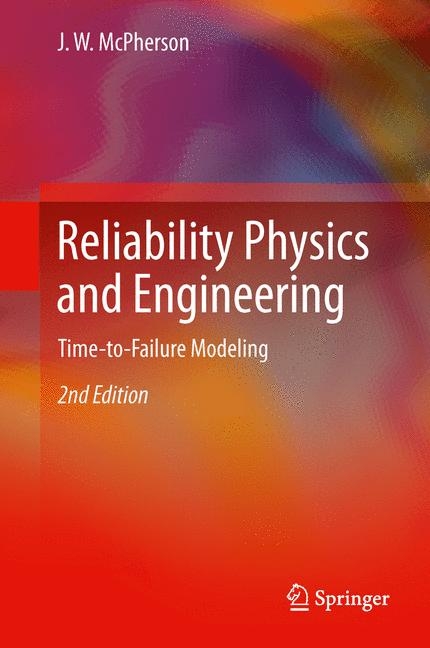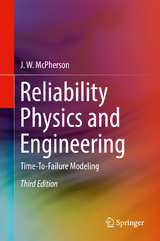Reliability Physics and Engineering
Springer International Publishing (Verlag)
978-3-319-00121-0 (ISBN)
- Titel erscheint in neuer Auflage
- Artikel merken
"Reliability Physics and Engineering" provides critically important information for designing and building reliable cost-effective products. The textbook contains numerous example problems with solutions. Included at the end of each chapter are exercise problems and answers. "Reliability Physics and Engineering" is a useful resource for students, engineers, and materials scientists.
Dr. J.W. McPherson is at McPherson Reliability Consulting, LLC.
1 Introduction
2 Materials and Device Degradation
2.1 Material/Device Parameter Degradation Modeling
2.1.1 Material/Device Parameter Decreases With Time
2.1.2 Material/Device Parameter Increases With Time
2.2 General Time-Dependent Degradation Models
2.3 Degradation Rate Modeling
2.4 Delays in the Start of Degradation
2.5 Competing Degradation Mechanisms
3 From Material/Device Degradation to Time-To-Failure
3.1 Time-To-Failure
3.2 Time-To-Failure Kinetics
4 Time-To-Failure Modeling
4.1 Flux-Divergence Impact on Time-To-Failure
4.2 Stress Dependence and Activation Energy
4.3 Conservative Time-To-Failure Models
4.4 Time-To-Failure Modeling Under High Stress
References
5 Gaussian Statistics – An Overview
5.1 Normal Distribution
5.2 Probability Density Function
5.3 Statistical Process Control
References
6 Time-To-Failure Statistics
6.1 Lognormal Probability Density Function
6.2 Weibull Probability Density Function
6.3 Multimodal Distributions
6.3.1 Multimodal Distribution (Separated In Time)
6.3.2 Mixed Multiple Failure Mechanisms
References
7 Failure Rate Modeling
7.1 Device Failure Rate
7.2 Average Failure Rate
7.2.1 Lognormal Average Failure Rate
7.2.2 Weibull Average Failure Rate
7.3 Instantaneous Failure Rate
7.3.1 Lognormal Instantaneous Failure Rate
7.3.2 Weibull Instantaneous Failure Rate
7.4 Bathtub Curve
7.5 Failure Rate for Electronic Devices
References
8 Accelerated Degradation
8.1 Metastable States
8.2 Impact of Temperature on Degradation Rate
8.3 Free-Energy of Activation
8.4 Impact of Stress and Temperature on Degradation Rate
8.4.1 Real Versus Virtual Stresses
8.4.2 Impact of Stress on Materials/Devices
8.5 Accelerated Degradation Rates
References
9 Acceleration Factor Modeling
9.1 Acceleration Factor
9.2 Power-Law Versus Exponential Acceleration
9.3 Cautions Associated with Accelerated Testing
9.4 Conservative Acceleration Factors
References
10 Ramp-To-Failure Testing
10.1 Ramp-To-Failure Testing
10.2 Linear Ramp-Rate
10.2.1 Linear Ramp with Exponential Acceleration
10.2.2 Linear Ramp with Power-Law Acceleration
10.3 Breakdown/Rupture Distributions
10.4 Cautions Associated With Ramp-To-Failure Testing
10.5 Transforming Breakdown/Rupture Distributions Into Constant-Stress Time-To-Failure Distributions
10.5.1 Transforming Breakdown/Rupture Distribution Time-To-Failure Distribution Using Exponential Acceleration
10.5.2 Transforming Breakdown/Rupture Distribution to Time-To-Failure Distribution Using Power-Law Acceleration
10.6 Constant-Stress Lognormal Time-To-Failure Distributions From Ramp Breakdown/Rupture Data
10.6.1 Exponential Acceleration
10.6.2 Power-Law Acceleration
10.7 Constant-Stress Weibull Time-To-Failure Distributions From Ramp Breakdown/Rupture Data
10.7.1 Exponential Acceleration
10.7.2 Power-Law Acceleration
References
11 Time-To-Failure Models for Selected Failure Mechanisms in Integrated Circuits
11.1 Electromigration (EM)
11.2 Stress Migration (SM)
11.2.1 SM in Aluminum Interconnects
11.2.2 SM in Copper Interconnects
11.3 Corrosion
11.3.1 Exponential Reciprocal-Humidity Model
11.3.2 Power-Law Humidity Model
11.3.3 Exponential Humidity Model
11.4 Thermal-Cycling/Fatigue Issues
11.5 Time-Dependent Dielectric Breakdown (TDDB)
11.5.1 Exponential E-Model
11.5.2 Exponential 1/E – Model
11.5.3 Power-Law Voltage V-Model
11.5.4 Exponential - Model
11.5.5 Which TDDB Model to Use
11.5.6 Complementary Electric-Field and Current-Models
11.6 Mobile-Ions/Surface-Inversion
11.7 Hot-Carrier Injection (HCI)
11.8 Negative-Bias Temperature Instability (NBTI)
References
12 Time-To-Failure Models for Selected Failure Mechanisms In Mechanical Engineering
12.1 Molecular Bonding in Materials
12.2 Origin of Mechanical Stresses in Materials
12.3 Elastic Behavior of Materials
12.4 Inelastic/Plastic Behavior of Materials
12.5 Important Defects Influencing Material Properties
12.5.1 Vacancies
12.5.2 Dislocations
12.5.3 Grain Boundaries
12.6 Fracture Strength of Materials
12.7 Stress Relief in Materials
12.8 Creep-Induced Failures
12.8.1 Creep Under Constant-Load/Stress Conditions
12.8.2 Creep Under Constant-Strain Conditions
12.9 Crack-Induced Failures
12.9.1 Stress Raisers/Risers at Crack Tips
12.9.2 Strain-Energy Release Rate
12.9.3 Fast Fracture/Rupture
12.10 Fatigue-Induced Failures
12.10.1 Fatigue for Materials (No Pre-Existing Cracks)
12.10.2 Low-Cycle Fatigue
12.10.3 High-Cycle Fatigue
12.10.4 Fatigue for Materials (With Pre-Existing Cracks)
12.11 Adhesion Failures
12.12 Thermal-Expansion Induced Failures
12.12.1 Thermal Expansion
12.12.2 Constrained Thermal Expansion
12.12.3 Thermal-Expansion Mismatch
12.12.4 Thin Films on Thick Substrates
12.13 Corrosion-Induced Failures
12.13.1 Dry Oxidation
12.13.2 Wet Oxidation
12.13.3 Impact of Stress on Corrosion Rates
References
13 Conversion of Dynamical Stresses Into Effective Static Values
13.1 Effective Static-Stress Equivalent Values
13.2 Effective Static-Stress Equivalent Values When Using Power-Law TF Models
13.3 Effective Static-Stress Equivalent Values When Using Exponential TF Models
13.4 Conversion Of A Dynamical Stress Pulse Into A Rectangular Stress Pulse Equivalent
13.4.1 Effective Rectangular Pulse Stress-Equivalent Values for Power-Law TF Models
13.4.2 Effective Rectangular Pulse Stress-Equivalent for Exponential TF Models
13.4.3 Numerical Integration
13.5 Effective Static-Temperature Equivalents
13.6 Mission Profiles
13.7 Avoidance of Resonant Frequencies
14 Increasing the Reliability of Device/Product Designs
14.1 Reliability Enhancement Factor
14.2 Electromigration Design Considerations
14.3 TDDB Design Considerations
14.4 NBTI Design Considerations
14.5 HCI Design Considerations
14.6 Surface Inversion Design Considerations
14.7 Creep Design Considerations
14.7.1 Creep in Rotors
14.7.2 Creep in Pressurized Vessels
14.7.3 Creep in Leaf Springs
14.7.4 Stress Relaxation in Clamps/Fasteners
14.8 Fatigue Design Considerations
14.8.1 Fatigue in Storage Vessels
14.8.2 Fatigue in Integrated Circuits
15 Screening
15.1 Breakdown/Strength Distribution for Materials and Devices
15.2 Impact of Screening Stress on Breakdown Strength
15.2.1 Screening Using Exponential TF Model
15.2.2 Screening Using Power-Law TF Model
15.3 Screening Effectiveness
15.3.1 Screening Effectiveness Using Exponential TF Model
15.3.2 Screening Effectiveness Using Power-Law TF Model
16 Heat Generation and Dissipation
16.1 Device Self-Heating and Heat Transfer
16.1.1 Energy Conservation
16.1.2 General Heat Flow Equation
16.2 Steady-State Heat Dissipation
16.3 Effective Thermal Resistance
16.4 General Transient Heating and Heat Dissipation
16.4.1 Effective Thermal Resistance Revisited
16.4.2 Heat Capacity
16.5 Modeling Dynamical Heat Generation and Dissipation
16.5.1 Thermal Relaxation
16.5.2 Thermal Rise with Constant Input Power
16.5.3 Thermal Rise and Relaxation with Single Power Pulse
16.5.4 Thermal Rises and Relaxations with Periodic Power Pulses
16.6 Convection Heat Transfer
16.7 Radiation Heat Transfer
16.8 Entropy Changes Associated With Heat Transfer
References
17 Sampling Plans and Confidence Intervals
17.1 Poisson Distribution
17.1.1 Poisson Probability for Finding Defective Devices
17.1.2 Poisson Sample-Size Requirements
17.2 Binomial Distribution
17.2.1 Binomial Probability for Finding Defective Devices
17.2.2 Binomial Sample-Size Requirements
17.3 Chi-Square Distribution
17.3.1 Chi-Square Confidence Intervals
17.3.2 Chi-Square Distribution for Defect Sampling
17.4 Confidence Intervals for Characteristic Time-To-Failure and Dispersion Parameters
17.4.1 Normal Distribution Confidence Intervals
17.4.2 Lognormal Distribution Confidence Intervals
17.4.3 Weibull Distribution Confidence Intervals
17.4.4 Chi-Square Distribution Confidence Intervals Average Failure Rates
References
Appendix A: Useful Conversion Factors
Appendix B: Useful Physical Constants
Appendix C: Useful Rough Rules-Of-Thumb
Appendix D: Useful Mathematical Expressions
Appendix E: Useful Differentials and Definite Integrals
Appendix F: Free-Energy
Appendix G: t(1-α/2,ν) Distribution Values
Appendix H: χ2(P,ν) Distribution Values
Index
| Erscheint lt. Verlag | 14.6.2013 |
|---|---|
| Zusatzinfo | XVI, 399 p. |
| Verlagsort | Cham |
| Sprache | englisch |
| Maße | 155 x 235 mm |
| Gewicht | 758 g |
| Themenwelt | Technik ► Elektrotechnik / Energietechnik |
| Schlagworte | device reliability • Failure Modeling and statistics • Failure Rate Reduction • Maintenance and Reliability • Probabilistic Models and Statistical Modeling • Quality Assurance Engineering • Reliability Engineering |
| ISBN-10 | 3-319-00121-3 / 3319001213 |
| ISBN-13 | 978-3-319-00121-0 / 9783319001210 |
| Zustand | Neuware |
| Haben Sie eine Frage zum Produkt? |
aus dem Bereich





